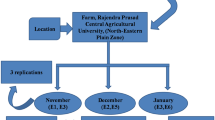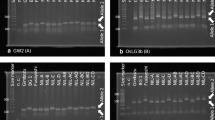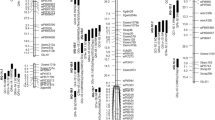Abstract
The study of QTL × environment interaction (QEI) is important for understanding genotype × environment interaction (GEI) in many quantitative traits. For modeling GEI and QEI, factorial regression (FR) models form a powerful class of models. In FR models, covariables (contrasts) defined on the levels of the genotypic and/or environmental factor(s) are used to describe main effects and interactions. In FR models for QTL expression, considerable numbers of genotypic covariables can occur as for each putative QTL an additional covariable needs to be introduced. For large numbers of genotypic and/or environmental covariables, least square estimation breaks down and partial least squares (PLS) estimation procedures become an attractive alternative. In this paper we develop methodology for analyzing QEI by FR for estimating effects and locations of QTLs and QEI and interpreting QEI in terms of environmental variables. A randomization test for the main effects of QTLs and QEI is presented. A population of F2 derived F3 families was evaluated in eight environments differing in drought stress and soil nitrogen content and the traits yield and anthesis silking interval (ASI) were measured. For grain yield, chromosomes 1 and 10 showed significant QEI, whereas in chromosomes 3 and 8 only main effect QTLs were observed. For ASI, QTL main effects were observed on chromosomes 1, 2, 6, 8, and 10, whereas QEI was observed only on chromosome 8. The assessment of the QEI at chromosome 1 for grain yield showed that the QTL main effect explained 35.8% of the QTL + QEI variability, while QEI explained 64.2%. Minimum temperature during flowering time explained 77.6% of the QEI. The QEI analysis at chromosome 10 showed that the QTL main effect explained 59.8% of the QTL + QEI variability, while QEI explained 40.2%. Maximum temperature during flowering time explained 23.8% of the QEI. Results of this study show the possibilities of using FR for mapping QTL and for dissecting QEI in terms of environmental variables. PLS regression is efficient in accounting for background noise produced by other QTLs.




Similar content being viewed by others
References
Aastveit H, Martens H (1986) ANOVA interactions interpreted by partial least squares regression. Biometrics 42:829–844
Beavis WD, Smith OS, Grant D, Fincher R (1994) Identification of quantitative trait loci using a small sample of topcrossed and F4 progeny from maize. Crop Sci 34:882–896
Bjornstad A, Westad F, Martens H (2004a) Analysis of genetic marker–phenotype relationships by jacknifed partial least squares regression (PLSR). Hereditas 141:149–165
Bjornstad A, Gronnerod S, Mac Key J, Tekauz A, Crossa J, Martens H (2004b) Resistance to barley scald (Rhynchosporium secalis) in the Ethiopian donor lines ‘Steudelli’ and ‘Jet’, analyzed by partial least squares regression and interval mapping. Hereditas 141:166–179
Blum A (1988) Plant breeding for stress environments. CRC Press, Boca Raton, FL
Bolaños J, Edmeades GO (1993) Eight cycles of selection for drought tolerance in lowland tropical maize. II. Responses in reproductive behavior. Field Crops Res 31:253–268
Caliński T, Kaczmarek Z, Krajewski P, Frova C, Sari-Gorla M (2000) A multivariate approach to the problem of QTL localization. Heredity 84:303–310
Churchill GA, Doerge RW (1994) Empirical threshold values for quantitative trait mapping. Genetics 138:963–971
Crossa J (1990) Statistical analyses of multilocation trials. Adv Agron 44:55–85
Crossa J, Vargas M, Van Eeuwijk FA, Jiang C, Edmeades GO, Hoisington D (1999) Interpreting genotype × environment interaction in tropical maize using linked molecular markers and environmental covariables. Theor Appl Genet 99:611–625
Denis J-B (1988) Two-way analysis using covariates. Statistics 19:123–132
Denis J-B (1991) Ajustement de modèles linéaires et bilinéaires sous contraintes linéaires avec données manquantes. Revue de Statistique Appliquée 39:5–24
Edmeades GO, Cooper M, Lafitte R, Zinselmeier C, Ribaut J-M, Habben JE, Löffler C and Bänziger M (2001) Abiotic stresses and staple crops. In: Nosberger J, Geiger HH, Struik PC (eds) Crop science: progress and prospects. Proceedings of the Third International Crops Science Congress, August 17–21, 2000, Germany. CABI, Wallingford, UK, pp 137–155
Hackett CA, Meyer RC, Thomas WTB (2001) Multi-trait QTL mapping in barley using multivariate regression. Genet Res 77:95–106
Haley CS, Knott SA (1992) A simple regression method for mapping quantitative trait loci in line crosses using flanking markers. Heredity 69:315–324
Hall AJ, Vilella F, Trapani N, Chimenti C (1982) The effects of water stress and genotype on the dynamics of pollen-shedding and silking in maize. Field Crops Res 5:349–363
Hwang JTG, Nettleton D (2003) Principal components regression with data-chosen components and related methods. Technometrics 45:70–79
Helland IS (1988) On the structure of partial least squares. Comm Statist Simulation Comput 17:581–607
Jiang C, Zeng Z-B (1997) Mapping quantitative trait loci with dominant and missing markers in various crosses for two inbred lines. Genetica 101:47–58
Lander ES, Botstein D (1989) Mapping Mendelian factors underlying quantitative traits using RFLP linkage maps. Genetics 121:185–199
Lynch M, Walsh B (1998) Genetics and the analysis of quantitative traits. Sinauer Assoc., Inc., Sunderland, pp 980
Manly BFJ (1997) Randomization, bootstrap and Monte Carlo methods in biology, 2nd edn. Chapman and Hall, London
Martínez O, Curnow RN (1992) Estimating the locations and the sizes of the effects of quantitative trait loci using flanking markers. Theor Appl Genet 85:480–488
Montgomery DC, Peck EA (1982) Introduction to linear regression analysis. Wiley, New York
Morris M, Dreher K, Ribaut J-M, Khairallah M (2003) Money matters (II): costs of maize inbred line conversion schemes at CIMMYT using conventional and marker-assisted selection. Mol Breed 11:235–247
Osten DW (1988) Selection of optimal regression models via cross-validation. J Chemometrics 2:39–88
Ribaut J-M, Hoisington DA (1998) Marker-assisted selection: new tools and strategies. Trends Plant Sci 3:236–239
Ribaut J-M, Hoisington DA, Deutsch JA, Jiang C, Gonzalez-de-Leon D (1996) Identification of quantitative trait loci under drought conditions in tropical maize 1. Flowering parameters and the anthesis-silking-interval. Theor Appl Genet 92:905–914
Ribaut J-M, Jiang C, Gonzalez-de-Leon D, Edmeades GO, Hoisington DA (1997) Identification of quantitative trait loci under drought conditions in tropical maize 2. Yield components and marker-assisted selection strategies. Theor Appl Genet 94:887–896
Ribaut J-M, Bänziger M, Setter T, Edmeades G, Hoisington D (2004) Genetic dissection of drought tolerance in maize: a case study. In: Nguyen H, Blum A (eds) Physiology and biotechnology integration for plant breeding. Marcel Dekker Inc., New York, pp 571–611
Sari-Gorla M, Caliński T, Kaczmarek Z, Krajewski P (1997) Detection of QTL × environment interaction in maize by a least squares interval mapping method. Heredity 78:146–157
Talbot M, Wheelwright AV (1989) The analysis of genotype × environment interactions by partial least squares regression. Biuletyn Oceny Odmian Zeszyt 21/22:19–25
Van Eeuwijk FA, Denis J-B, Kang MS (1996) Incorporating additional information on genotypes and environments in models for two-way genotype by environment tables. In: Kang MS, Gauch HG Jr (eds) Genotype-by-environment interaction: new perspectives. CRC Press, Boca Raton, FL, pp 15–49
Van Eeuwijk FA, Crossa J, Vargas M, Ribaut J-M (2000) Variants of factorial regression for analysing QTL by environment interaction In: Gallais A, Dillmann C, Goldringer I (eds) Eucarpia, quantitative genetics and breeding methods: the way ahead. INRA edn. Versailles. Les colloques 96:107–116
Van Eeuwijk FA, Crossa J, Vargas M, Ribaut J-M (2002) Analyzing QTL-environment interaction by factorial regression, with an application to the CIMMYT drought and low-nitrogen stress programme in maize. In: Kang MS (ed) Quantitative genetics, genomics and plant breeding. CABI International, New York
Vargas M, Crossa J, Sayre K, Reynolds M, Ramírez ME, Talbot M (1998) Interpreting genotype × environment interaction in wheat using partial least squares regression. Crop Sci 38:679–689
Vargas M, Crossa J, Van Eeuwijk FA, Ramírez ME, Sayre K (1999) Using AMMI, factorial regression, and partial least squares regression models for interpreting genotype × environment interaction. Crop Sci 39:955–967
Westgate ME, Bassetti P (1990) Heat and drought stress in corn: what really happens to the corn plant at pollination?. In: Wilkinson D (ed) Proceedings of the 45th Annual Corn and Sorghum Research Conference, ASTA, Washington, pp12–28
Zeng Z-B (1994) Precision mapping of quantitative trait loci. Genetics 136:1457–1468
Author information
Authors and Affiliations
Corresponding author
Additional information
Communicated by A. E. Melchinger
Rights and permissions
About this article
Cite this article
Vargas, M., van Eeuwijk, F.A., Crossa, J. et al. Mapping QTLs and QTL × environment interaction for CIMMYT maize drought stress program using factorial regression and partial least squares methods. Theor Appl Genet 112, 1009–1023 (2006). https://doi.org/10.1007/s00122-005-0204-z
Received:
Accepted:
Published:
Issue Date:
DOI: https://doi.org/10.1007/s00122-005-0204-z




